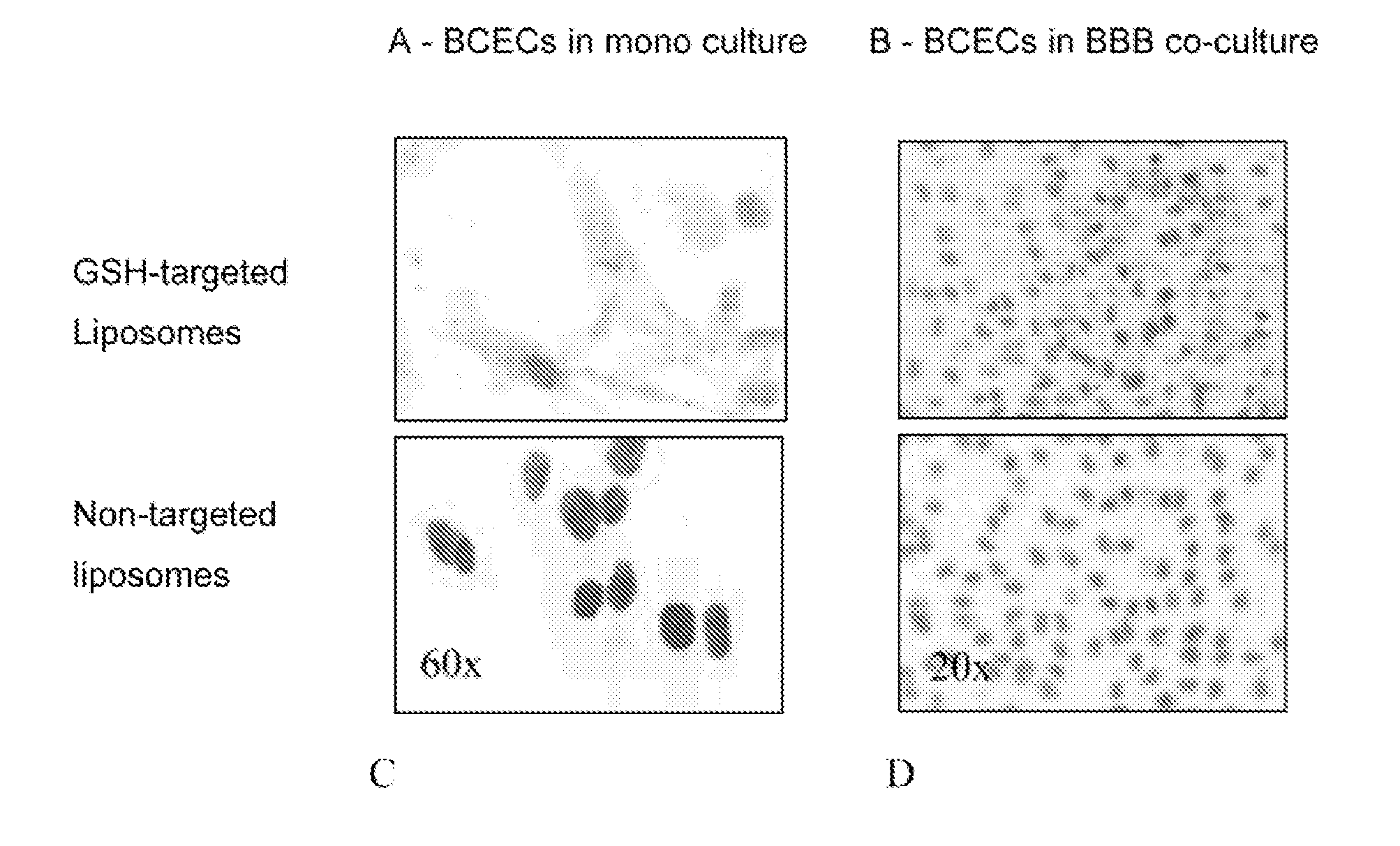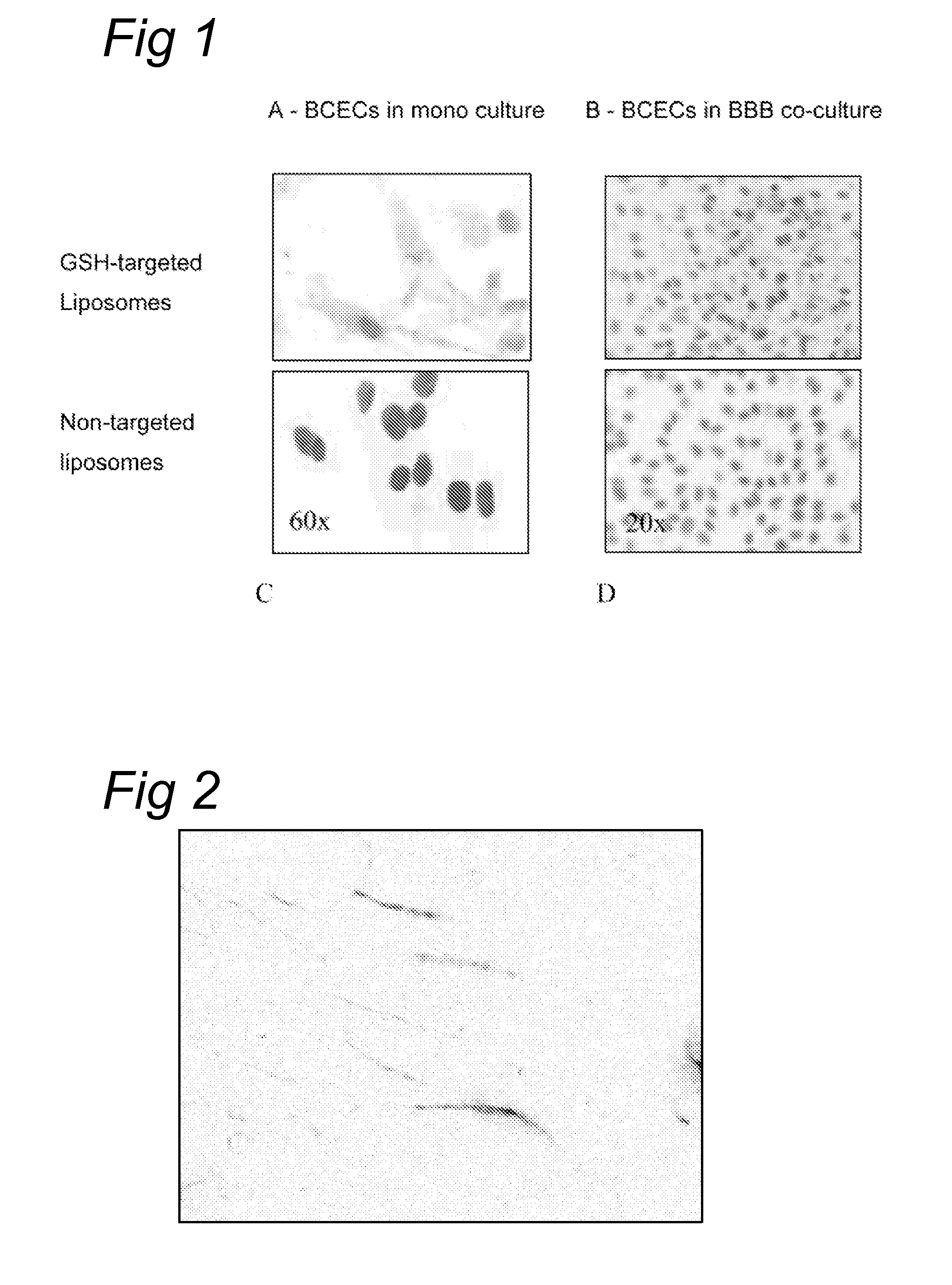Glutathione-based drug delivery system
a drug delivery and glutathione technology, applied in the direction of peptide/protein ingredients, granular delivery, powder delivery, etc., can solve the problems of drug uptake by all body tissues, complicated classical drug therapy (i.e. targeted against neurons) of brain disorders, and the delivery of xenobiotics to the brain, etc., to achieve high affinity and specificity of binding
- Summary
- Abstract
- Description
- Claims
- Application Information
AI Technical Summary
Benefits of technology
Problems solved by technology
Method used
Image
Examples
example 1
Conjugation of Agents to Receptor-Specific Ligands
[0094]As an example of conjugation of agents to GSH, the preferred method of conjugation of GSH to protein drugs is disclosed. Similar conjugation chemistry is applied to the other herein disclosed agents, and the other herein disclosed GSH derivatives. In order to visualize the GSH-transporter specific cellular uptake, as well as the in vivo pharmacokinetics and biodistribution of GSH conjugated to a hydrophilic agent, GSH is labelled with the hydrophilic fluorescent dye fluorescein isothiocyanate (FITC) or Cy5.5. For this, GSH is dissolved in PBS and NaHCO3 pH 9.0. FITC or Cy5.5 is added and the solution is stirred, in the dark, for 1 hr at room temperature. The excess of FITC or Cy5.5 is removed by column centrifugation (Zeba™, Pierce, Rockford, USA) after which the solution is stored in the dark at 4° C.
example 2
Conjugation of GSH-Transporter Specific Ligands to Nanocontainers Containing Encapsulated Agents, and Pharmacokinetics and Pharmacodynamics Thereof
[0095]As an example of agent-containing nanocontainers coated with GSH-transporter specific ligands, the preferred method of conjugation of GSH to drug-loaded PEGylated liposomes is disclosed. Liposomes consist of phospholipids and cholesterol in several molar ratios (e.g., 2.0:1.5). In order to modify the transition / processing temperature and particle stability in plasma, phospholipids like 1,2-dipalmitoyl-sn-glycero-3-phosphocholine (DPPC), dimyristoylphosphatidylcholine (DMPC), hydrogenated soy phosphatidylcholine (HSPC), soy phosphatidylcholine (SPC), distearoyl phosphatidylcholine (DSPC), or egg yolk phosphatidylcholine (EYPC) are used in different ratios with cholesterol (Chol), where less Chol in the mixture will result in less stable liposomes in plasma. Components are dissolved in ethanol or isopropanol. Micelles containing DSPE-...
example 3
Conjugation of GSH to Carrier for Nucleic Acid-Based Drugs
[0101]As an example of a non-viral delivery system for nucleic acid-based drugs by means of a targeted uptake mechanism, the preferred method of conjugation of PEGylated GSH to polyethylenimine (PEI), jetPEI, and the like or fragments thereof, is disclosed. PEGylated complexes are prepared as follows. PEI is dissolved in PBS. Poly(ethyleneglycol)-α-maleimide-ω-NHS (NHS-PEG-VS) is added to this solution and incubated at room temperature while mixing. The excess of NHS-PEG-VS is removed by ultrafiltration. PEI-PEG-VS is used directly for conjugation to the thiol group of reduced GSH.
PUM
| Property | Measurement | Unit |
|---|---|---|
| Fraction | aaaaa | aaaaa |
| Time | aaaaa | aaaaa |
Abstract
Description
Claims
Application Information
 Login to View More
Login to View More - R&D
- Intellectual Property
- Life Sciences
- Materials
- Tech Scout
- Unparalleled Data Quality
- Higher Quality Content
- 60% Fewer Hallucinations
Browse by: Latest US Patents, China's latest patents, Technical Efficacy Thesaurus, Application Domain, Technology Topic, Popular Technical Reports.
© 2025 PatSnap. All rights reserved.Legal|Privacy policy|Modern Slavery Act Transparency Statement|Sitemap|About US| Contact US: help@patsnap.com



